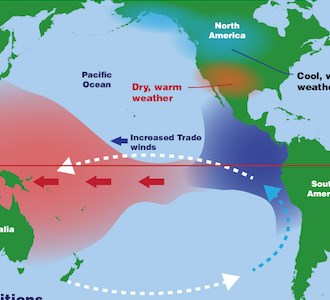Australia declares ‘La Nina weather event begins’
Weather bureau of Australia declared on November 23, 2021 that; a La Nina weather phenomenon had developed in Pacific Ocean for the second consecutive year.
Highlights
- Development of this phenomenon will bring above average rainfall across central, north and east Australia.
- This event could boost wheat yields in Australia.
- In September 2021, India had increased its wheat forecast for this season by 17 per cent to near record levels because of favourable weather.
- This year, climatic models suggest, La Nina pattern will be short-lived, and will be effective until late southern hemisphere summer or early autumn 2022.
What is La Nina?
La Nina is an oceanic and atmospheric phenomenon, which is a colder counterpart of El Nino. It is a part of broader El Nino–Southern Oscillation (ENSO) climate pattern. Name of La Nina originates from Spanish for ‘the girl’. Phenomenon of La Nina is usually associated with more tropical cyclones, greater rainfall, and cooler than average temperatures in equatorial Pacific Ocean. The events typically last about a year.
What happens during La Nina?
During La Nina period, sea surface temperature across eastern equatorial part of central Pacific Ocean becomes lower than normal by 3–5 °C.
Impact of La Nina
La Nina has an extensive effect on weather worldwide, especially in North America. It also impacts the Atlantic and Pacific hurricane seasons, in which number of tropical cyclones increases in Atlantic basin because of low wind shear and warmer sea surface temperatures. It also reduces tropical cyclogenesis in Pacific Ocean.
Month: Current Affairs - November, 2021


